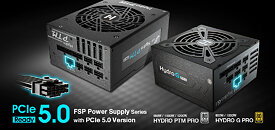- Joined
- Oct 9, 2007
- Messages
- 47,194 (7.56/day)
- Location
- Hyderabad, India
| System Name | RBMK-1000 |
|---|---|
| Processor | AMD Ryzen 7 5700G |
| Motherboard | ASUS ROG Strix B450-E Gaming |
| Cooling | DeepCool Gammax L240 V2 |
| Memory | 2x 8GB G.Skill Sniper X |
| Video Card(s) | Palit GeForce RTX 2080 SUPER GameRock |
| Storage | Western Digital Black NVMe 512GB |
| Display(s) | BenQ 1440p 60 Hz 27-inch |
| Case | Corsair Carbide 100R |
| Audio Device(s) | ASUS SupremeFX S1220A |
| Power Supply | Cooler Master MWE Gold 650W |
| Mouse | ASUS ROG Strix Impact |
| Keyboard | Gamdias Hermes E2 |
| Software | Windows 11 Pro |
FSP Group, the leading manufacturer of high-performance power supplies today, announces product compliance with INTEL PSDG ATX 3.0 and PCIe 5.0 for the ultimate performance enhancement.
The retail models of FSP's consumer-based power supply range are getting a major overhaul with the addition of INTEL Power design guide ATX 3.0 and PCIe 5.0 specification compliance, packing more power and stability that is tailor-made for high demand systems. Traditional power supplies need three 8-pin to 16-pin adapters to support the latest PCIe Gen 5.0 graphics cards. FSP looks to address this drawback with their latest iteration of PSUs, unlocking seamless integration with all the latest hardware in the market.

The newly upgraded power supplies from FSP Hydro G PRO 850 W/1000 W series and Hydro PTM PRO 850 W/1000 W/1200 W series carry the PCIe 5.0 CEM (12VHPWR) interface and the corresponding 12+4 Pin cable. Experience unparalleled performance boost with more than 600 W of power, ideal for the latest power-hungry GPUs in the market highly beneficial for better overclock numbers with stable power delivery.
FSP announces that the upgraded PSU versions will come with clear visual labeling on their packaging to let users easily identify the upgraded version from older models and the obvious changes in the modular ports in the unit itself.
FSP is determined to meet the needs of the current and future generation of high-end graphic cards and to provide high-quality and stable power for any hardware in the market. Enjoy unhindered gaming experiences supported with FSP's globally renowned product quality and durability.
View at TechPowerUp Main Site
The retail models of FSP's consumer-based power supply range are getting a major overhaul with the addition of INTEL Power design guide ATX 3.0 and PCIe 5.0 specification compliance, packing more power and stability that is tailor-made for high demand systems. Traditional power supplies need three 8-pin to 16-pin adapters to support the latest PCIe Gen 5.0 graphics cards. FSP looks to address this drawback with their latest iteration of PSUs, unlocking seamless integration with all the latest hardware in the market.

The newly upgraded power supplies from FSP Hydro G PRO 850 W/1000 W series and Hydro PTM PRO 850 W/1000 W/1200 W series carry the PCIe 5.0 CEM (12VHPWR) interface and the corresponding 12+4 Pin cable. Experience unparalleled performance boost with more than 600 W of power, ideal for the latest power-hungry GPUs in the market highly beneficial for better overclock numbers with stable power delivery.
FSP announces that the upgraded PSU versions will come with clear visual labeling on their packaging to let users easily identify the upgraded version from older models and the obvious changes in the modular ports in the unit itself.
FSP is determined to meet the needs of the current and future generation of high-end graphic cards and to provide high-quality and stable power for any hardware in the market. Enjoy unhindered gaming experiences supported with FSP's globally renowned product quality and durability.
View at TechPowerUp Main Site



